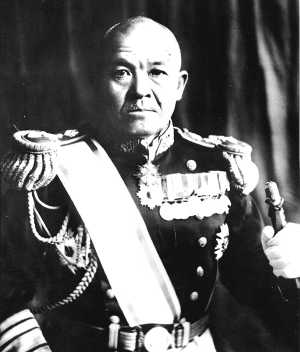- Author
- Thomas, Mitchell, Midshipman, RAN
- Subjects
- Biographies and personal histories, WWII operations, History - WW2
- Tags
-
- RAN Ships
- None noted.
- Publication
- December 2006 edition of the Naval Historical Review (all rights reserved)
Royal Australian Naval College New Entry Officers’ Course History Essay – Prizewinner
INTRODUCTION:
‘But for chance and a critical loss of nerve by the Japanese commander (author’s emphasis), the attack on Pearl Harbour could have been far more devastating to America than it actually was.’
The above quotation by M. Miller Baker to the Joint Hearing Before the Committee on Rules and Administration on 13th December 2003, illustrates that there persists a belief that the Japanese Admiral Nagumo’s decision not to launch a third strike on Pearl Harbour on the afternoon of 7th December 1941, or the morning of 8th December 1941 was a major military blunder that significantly contributed to later Japanese naval losses and ultimate defeat in the war.

(Photo: Naval Historical Centre, Washington DC)
Vice Admiral Chuichi Nagumo (1887-1944) commanded the Japanese 1st Carrier Division during the early stages of the Second World War. During this time and in the years immediately after the war, many Allied and Japanese senior naval officers such as Admiral Chester Nimitz ((Prange, G Pearl Harbour, The Verdict of History, 1986, New York, McGraw-Hill Book Company, p 50.)), Admiral Thomas Hart ((Stillwell, P, (ed) Air Raid: Pearl Harbour! Recollections of a Day of Infamy, 1981, Annapolis, Naval Institute Press, p 58.)) and Commander Mitsuo Fuchida ((Renzi, W, & Roehrs, M, Never Look Back, A History of World War II in the Pacific, 1991, New York, M E Sharp Inc, p 43.)), expressed the belief that timidity and lack of understanding of the power of naval aviation by Admiral Nagumo led him to make a major strategic mistake. This mistake negated any benefits accrued from his tactical victory against the American Pacific Fleet at Pearl Harbour.
On the other hand, others have argued that it was not only his lack of understanding and timidity, but also his poor leadership that contributed to his mistake. Mitsuo Fuchida, who served under Nagumo as the strike commander of the air attack, evaluated his credentials as a commander and leader thus: ‘Nagumo’s leadership as a commander was extremely conservative and he would never take the initiative. In the end, he would always agree with his Staff Officers’ opinions. The credentials of a true commander are the ability to foresee the development of a battle and calculate accordingly. These qualities were lacking in Commander-in-Chief Nagumo. ((Ikeda, K, Men of War – Ice Admiral Chuichi Nagumo, 1992, London Weidenfeldt and Nicholson.))
However, after extensive research into this topic, I believe that Admiral Nagumo was a capable leader who has been unfairly criticised by those who were not completely aware of all the circumstances that surrounded his decisions.
Significant Achievements and Failures
Chuichi Nagumo was born Shinobu-Machi in Yomezawa City in March 1887. In November 1908, he graduated from Etajima Naval Academy and took up his first posting as a naval cadet on the naval vessel Soya. He was promoted to Midshipman in October 1910 and graduated from the Torpedo School at the top of his senior class in November, 1914 (( Japanese Naval Officers, 2004, http://www.combinedfleet.com/officer.htm (accessed 23/03/06)).
He earned his first command in 1917 and until 1935, had various commands, including the battleship Yamashiro. In 1935, he commanded the 1st Torpedo Squadron, and was promoted to Rear Admiral. Despite his lack of naval aviation experience, in 1941 he was made Commander-in-Chief of the 1st Carrier Division. He was best known for this command; it was also his most controversial. ((Nagumo, Chuichi, 2006, Reader’s Companion to Military History, http://www.college.hmco.com/history/readerscomp/mil/html/mh_036300_nagumochuichi.htm (accessed 23/03/06))
7th December 1941
On the morning of 7th December 1941, the Japanese Fleet of six aircraft carriers, commanded by Vice Admiral Nagumo, was positioned 370 kilometres north of Hawaii. It launched a total of 360 planes in two waves against Pearl Harbour and surrounding airfields. For the loss of 29 aircraft and 55 airmen killed, this force sank or crippled 21 US Navy ships, destroyed 188 American planes, damaged another 155, and killed 2403 Americans. ((Lord, W, 1998, Day of Infamy, London, Wordsworth Editions.)) The principal offensive units of the American Pacific Fleet, the battleships, were rendered ineffective, and the crippled American Navy was incapable of launching any major offensive action against the rampaging Imperial Japanese forces in South-East Asia for at least the next six to twelve months.
Post-Pearl Harbour
After Pearl Harbour, Nagumo was responsible for raids all across the Pacific and Indian Oceans. At the end of his trip into the Indian Ocean, he was responsible for the sinking of five battleships, one carrier, two cruisers, seven destroyers, dozens of merchantmen, transports and other vessels. He was also responsible for the destruction of hundreds of Allied aircraft and damage to many Allied ports. All of this was at a cost of no more than a few dozen pilots. ((Nagumo, Chuichi, 2005, http://www.ww2db.com/person_bio.php?person_id=11, (accessed 20/03/06)))




